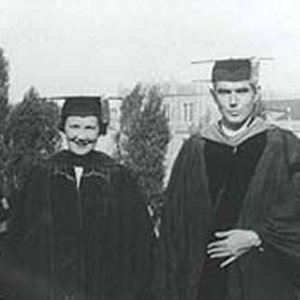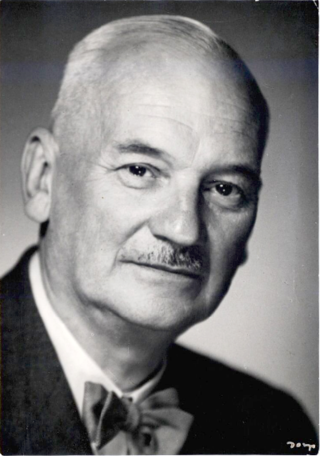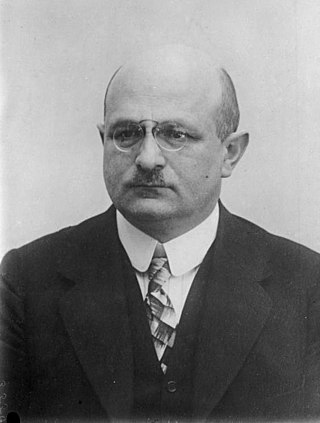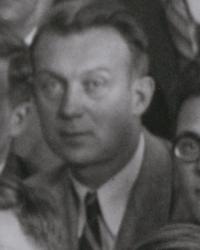Related Research Articles

Arnold Johannes Wilhelm Sommerfeld, was a German theoretical physicist who pioneered developments in atomic and quantum physics, and also educated and mentored many students for the new era of theoretical physics. He served as doctoral supervisor and postdoc supervisor to seven Nobel Prize winners and supervised at least 30 other famous physicists and chemists. Only J. J. Thomson's record of mentorship offers a comparable list of high-achieving students.

Max Theodor Felix von Laue was a German physicist who received the Nobel Prize in Physics in 1914 for his discovery of the diffraction of X-rays by crystals.

Albrecht Otto Johannes Unsöld was a German astrophysicist known for his contributions to spectroscopic analysis of stellar atmospheres.

Paul Peter Ewald, FRS was a German crystallographer and physicist, a pioneer of X-ray diffraction methods.

Léon Nicolas Brillouin was a French physicist. He made contributions to quantum mechanics, radio wave propagation in the atmosphere, solid-state physics, and information theory.
Rudolf Seeliger was a German physicist who specialized in electric discharges in gases and plasma physics.
Otto Laporte was a German-born American physicist who made contributions to quantum mechanics, electromagnetic wave propagation theory, spectroscopy, and fluid dynamics. His name is lent to the Laporte rule in spectroscopy and to the Otto Laporte Award of the American Physical Society.

Karl Ferdinand Herzfeld was an Austrian-American physicist.
Wilhelm Lenz was a German physicist, most notable for his invention of the Ising model and for his application of the Laplace–Runge–Lenz vector to the old quantum mechanical treatment of hydrogen-like atoms.
Gregor Wentzel was a German physicist known for development of quantum mechanics. Wentzel, Hendrik Kramers, and Léon Brillouin developed the Wentzel–Kramers–Brillouin approximation in 1926. In his early years, he contributed to X-ray spectroscopy, but then broadened out to make contributions to quantum mechanics, quantum electrodynamics, and meson theory.

Walther Ludwig Julius Kossel was a German physicist known for his theory of the chemical bond, Sommerfeld–Kossel displacement law of atomic spectra, the Kossel-Stranski model for crystal growth, and the Kossel effect. Walther was the son of Albrecht Kossel who won the Nobel Prize in Physiology or Medicine in 1910.
Erwin Richard Fues, was a German theoretical physicist who made contributions to atomic physics and molecular physics, quantum wave mechanics, and solid-state physics.
B. Adolf Kratzer was a German theoretical physicist who made contributions to atomic physics and molecular physics, and was an authority on molecular band spectroscopy. He was born in Günzburg and died in Münster.

Helmut Hönl was a German theoretical physicist who made contributions to quantum mechanics and the understanding of atomic and molecular structure.

Wojciech Sylwester Piotr Rubinowicz was a Polish theoretical physicist who made contributions in quantum mechanics, mathematical physics, and the theory of radiation. He is known for the Maggie-Rubinowicz representation of Gustav Kirchhoff’s diffraction formula.
Karl Glitscher was a German physicist who made contributions to quantum mechanics.

Carl Wilhelm Ramsauer was a German professor of physics and research physicist, famous for the discovery of the Ramsauer–Townsend effect. He pioneered the field of electron and proton collisions with gas molecules.
Arnold Rudolf Karl Flammersfeld was a German nuclear physicist who worked on the German nuclear energy project during World War II. From 1954, he was a professor of physics at the University of Göttingen.

Hans Kopfermann was a German atomic and nuclear physicist. He devoted his entire career to spectroscopic investigations, and he did pioneering work in measuring nuclear spin. During World War II, he worked on the German nuclear energy project, also known as the Uranium Club.
Jagdish Mehra was an Indian-American historian of science.
References
- Mehra, Jagdish, and Helmut Rechenberg The Historical Development of Quantum Theory. Volume 1 Part 1 The Quantum Theory of Planck, Einstein, Bohr and Sommerfeld 1900–1925: Its Foundation and the Rise of Its Difficulties. (Springer, 2001) ISBN 0-387-95174-1
- Mehra, Jagdish, and Helmut Rechenberg The Historical Development of Quantum Theory. Volume 1 Part 2 The Quantum Theory of Planck, Einstein, Bohr and Sommerfeld 1900–1925: Its Foundation and the Rise of Its Difficulties. (Springer, 2001) ISBN 0-387-95175-X
- Mehra, Jagdish, and Helmut Rechenberg The Historical Development of Quantum Theory. Volume 2 The Discovery of Quantum Mechanics 1925. (Springer, 2001) ISBN 0-387-95176-8